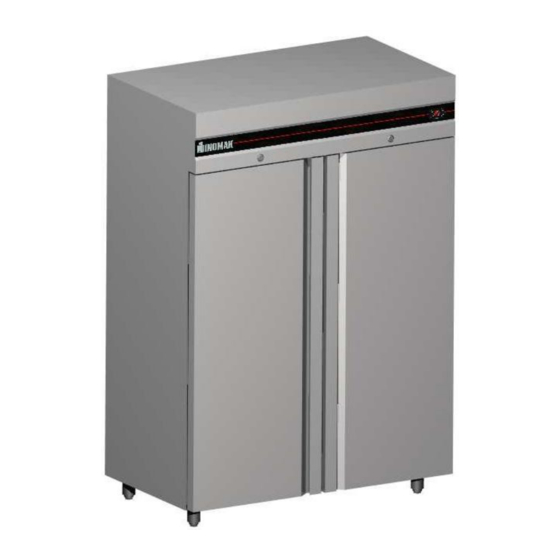
Table of Contents
Advertisement
UPRIGHT FREEZERS INSTALLATION, OPERATING AND MAINTENANCE INSTRUCTIONS
ΟΔΗΓΙΕΣ ΕΓΚΑΤΑΣΤΑΣΗΣ, ΧΡΗΣΗΣ ΚΑΙ ΣΥΝΤΗΡΗΣΗΣ ΨΥΓΕΙΩΝ ΘΑΛΑΜΩΝ ΚΑΤΑΨΥΞΗΣ
INSTALLATION DES CONGÈLATEURS VERTICAUX, INSTRUCTIONS D'UTILISATION ET D'ENTRETIEN
INSTALLATIONS-, BEDIENUNGS- UND WARTUNGSANLEITUNG FÜR AUFRECHTSTEHENDE TIEFKÜHLUNG
Models
CBS170
Version: E13052015CK
CFS2140
Advertisement
Table of Contents

Summarization of Contents
Transportation, Positioning, and Installation
Safe Handling and Upright Transport
Ensure the device is kept upright during transport, installation, and handling to prevent issues.
Packaging Removal and Final Positioning
Remove all packaging and carefully move the device to its final location.
Starting Up
Grounding Requirement for Power Socket
Ensure the power socket used for connection is properly grounded.
Thermostat Operation
Initial Thermostat Self-Check and Compressor Start
Thermostat performs self-check; compressor starts after a 2-minute delay.
Product Storage During Initial Cooling
Do not store products until the regulated temperature is reached.
Instructions for Correct Operation
Optimizing Air Circulation for Products
Store products to avoid blocking air circulation and keep within shelf margins.
Food Storage Guidelines
Avoiding Hot Food and Acidic Fumes
Do not store hot food; cover and seal products with acidic fumes properly.
Fault Codes on the Display
Sensor Failure Alarms (LF1, LF2)
Codes for room or evaporator sensor failure, requiring technical assistance.
Door Alarm Status (dor)
Indicates the door has been left open, requiring it to be closed.
Cleaning
Safety Precaution: Disconnect Power Before Cleaning
Always disconnect the plug from the electrical supply before starting any cleaning.
General Cleaning Recommendations
Frequent cleaning is recommended for correct operation and appliance protection.
Avoiding Damage During Cleaning
Do not use sharp objects that could damage the appliance.
Specific Cleaning Instructions
Interior and Exterior Surface Cleaning
Clean surfaces with a mild soap solution.
Detergent Restrictions for Stainless Steel
Avoid chlorine or acid solvents to prevent corrosion of surfaces and pipes.
Cleaning the Drain Hose
Drain Hose Removal and Caution
Remove drain hose carefully, avoiding damage to the flexible resistance.
Turning the Appliance Off for Long Periods of Time
Appliance Shutdown Procedure for Extended Storage
Steps include turning off, disconnecting, cleaning, and leaving doors open.
Saving Energy Advices
Optimizing Door Usage and Placement for Efficiency
Open doors only when needed; avoid placing near heat sources or sunlight.
Efficient Product Loading for Energy Consumption
Avoid filling with large quantities of products at once to save energy.
Maintenance
Pre-Maintenance Safety: Power Disconnection
Always disconnect the plug from the electrical supply before performing maintenance.
Thermostat Controller Instructions Manual
Unlocking the Thermostat and Basic Operation
Sequence to unlock thermostat and understand initial display messages.
Thermostat Operations and Parameter Settings
Parameter Menu Navigation and Value Changes
Steps to enter, scroll, change, and exit the thermostat parameter menu.
On/Off Switch and Alarm Muting Functions
Procedures for switching the device on/off and silencing temperature alarms.
Manual Defrost Cycle Initiation
How to start a manual defrost cycle using the control key.
Viewing Evaporator Temperature
Procedure to display the evaporator temperature readings.
Thermostat Indicator Status
Understanding Standby, Compressor, and Fan Operation Displays
Meanings of different indicator lights and states on the thermostat display.
Fault Code Display and Interpretation
Refrigerator Defrosting Status and Sensor Failures (dFr, LF1, LF2)
Indicates defrosting status and failures of room/evaporator sensors.
Thermostat Lock, Door, and High Temperature Alarms (Loc, dor, AH)
Alarms for thermostat lock, open door, and high ambient temperature.
Additional Faults and Alarm Handling
Low Temperature and System Error Indicators (ALo, Err)
Codes for low temperature, condensate water resistance, and memory faults.
Alarm Silencing and Parameter Reset Operations
How to silence audible alarms and reset parameters via button combinations.
Troubleshooting Common Issues
Addressing Cooling Failures and Evaporator Ice
Solutions for the appliance not cooling and ice accumulation in the evaporator.
Resolving Airflow Obstruction and Ambient Issues
Tips for product placement, ambient temperature, and humidity problems.
Managing Internal Water and Drainage Blockages
How to fix water leaks and clear blocked drainage pipes.
Contacting Distributor for Malfunctions
Providing Model and Serial Number for Support
Details needed when contacting distributors for service.
Locating the Appliance Identification Tag
Where to find the technical specifications and identification label on the appliance.

Need help?
Do you have a question about the CFS2140 and is the answer not in the manual?
Questions and answers